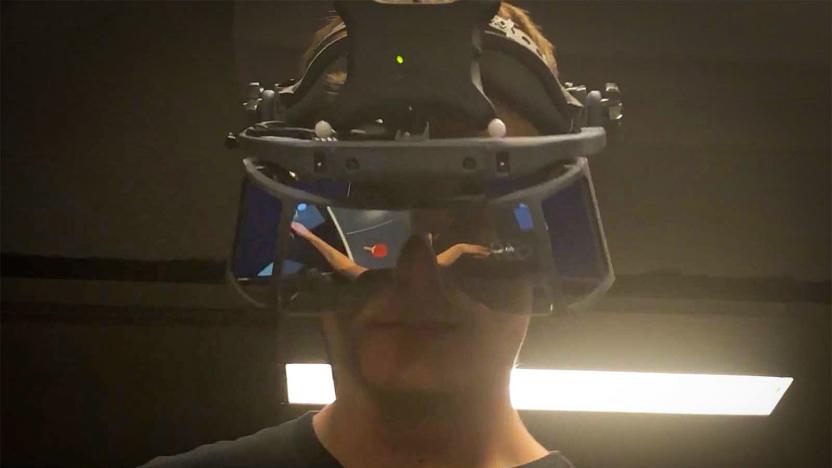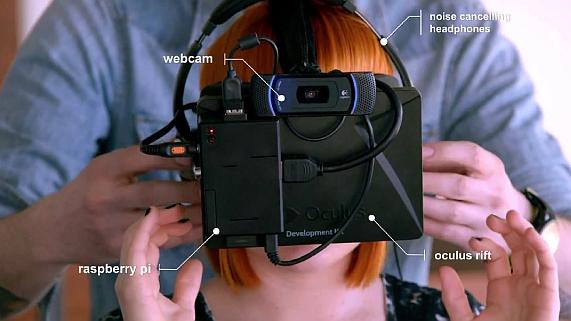pingpong
Latest

OMRON's redesigned ping pong robot no longer holds back
OMRON is best known for its healthcare products like thermometers and blood pressure monitors -- now in the form of a smartwatch, even. But those who have been following our CEATEC coverage over the past five years may remember the company's ambitious exhibit: the Forpheus table tennis robot. Little did I know that I would bump into this old friend here at CES. The machine is now in its fifth generation and packed with some surprising upgrades -- let's just say my parents would be disappointed in me if they were there.

Leap Motion shows off AR headset with rousing game of ping pong
If you wanted to demonstrate Leap Motion's low-cost augmented reality headset, how would you do it? Create a flashy, action-packed showcase? Leap Motion has a different idea: an invigorating game of ping pong. The company has crafted a demo that combines the Project North Star headgear with paddle controllers to pit the wearer against an AI opponent at a real ping pong table. It's not mind boggling by any stretch, but it's a good example of a fast, intuitive AR experience that depends on high accuracy. You can juggle the ball and serve it as naturally as you would if it were real. And importantly, there are behind-the-scenes developments that could influence AR going forward.

OMRON's updated ping pong robot can serve and take smashes
It's CEATEC, so I knew OMRON would once again bring out its massive table tennis robot to belittle us humans, but what I didn't expect was a significant performance jump this time. FORPHEUS, now at its fourth generation, features improved AI to boost its responsiveness -- so much that it can now predict and attempt to deal with smashes. Compared to the earlier versions which went easy on me, I found this one to be far more enjoyable with faster rallies. Better yet, there's now a companion robot arm that throws a ball up and lets FORPHEUS serve, thus making the robot a more realistic trainer or opponent.

ICYMI: Bot is my co-pilot
try{document.getElementById("aol-cms-player-1").style.display="none";}catch(e){}Today on In Case You Missed It: DARPA's autopilot system for military planes is being tested, this time in a Cessna Caravan turboprop plane. It's made up of a robotic arm and tablet with speech recognition, so communicating with the mechanical brain is supposed to be even easier. Meanwhile, ping-pong fans will want to know about new paddles that set the music based on the pace of the rally. A new product designed for gamers with haptic actuators is here, while just for kicks, the Price is Right celebration is here. As always, please share any interesting tech or science videos you find by using the #ICYMI hashtag on Twitter for @mskerryd.

Smart ping pong paddles remix music to the speed of play
I love playing table tennis, but my backhand topspin is average at best. I'll play for an hour and grow tired of chasing wayward balls, knowing that I'll never have a smash quite like Peco from Ping Pong. Never mind -- now I can cut loose with a game of "Ping Pong FM" instead. The modified bats, which have contact microphones inside, log when you've hit the ball and remix music accordingly. Exchange slices too slowly and the song will drop to a lower tempo; likewise, driving the ball with some vicious top spin will cause it to speed up. You can try to match the beat or purposefully remix the music in weird and wonderful ways -- it's entirely up to you.

The Pongbot makes beer pong actually challenging
If you ever went to a party in college, chances are you've played beer pong. You throw a ball into a cup filled with beer, and a successful shot means your opponent has to take a drink. It's a way to make drinking a bit more social and competitive. It's also not something you do past a certain age -- maybe because of the frat house association, but also because it's not that hard. It's not supposed to be, given that the point is to get drunk. The Pongbot, a $40 device hitting Kickstarter today, shakes things up by making those beer-filled tumblers a moving target. You might not get drunk as fast, but you'll definitely feel the high of increased competition.

ICYMI: 3D-printed instrument, Humanoid diver and more
#fivemin-widget-blogsmith-image-99267{display:none;} .cke_show_borders #fivemin-widget-blogsmith-image-99267, #postcontentcontainer #fivemin-widget-blogsmith-image-99267{width:570px;display:block;} try{document.getElementById("fivemin-widget-blogsmith-image-99267").style.display="none";}catch(e){}Today on In Case You Missed It: Free 3D plans to create your own plastic violin should make the instrument a bit easier to take up; Stanford roboticists created a remotely-operated humanoid diver that can be haptically controlled from afar by its pilots, meaning they can feel what the diver does. And a table tennis projector can coach you on improving your lousy game, so nothing like this ever happens to you. Sick of those updates popping up during important moments? It can't be as bad as being live on-air. As always, please share any great tech or science videos you find by using the #ICYMI hashtag on Twitter for @mskerryd.

Drone fights fires by dropping flaming balls
The thought of a fire-starting robot would normally have us fleeing in terror, but we'll make an exception for this one. Researchers are developing a drone, the Unmanned Aerial System for Fire Fighting (UAS-FF), that helps contain and prevent fires by dropping ping pong-sized flaming balls. If you need to burn grass before it fuels an uncontrolled blaze, you just program the drone to drop its chemically-ignited cargo in a specific pattern -- you don't have to send in a costly aircraft or face the risks of starting fires on the ground. It'll be a while before you see UAS-FF in service, but it's already nice to see a drone that helps firefighting instead of getting in the way. [Image credit: Craig Chandler/University Communications]

A robot made me (marginally) better at ping pong
We're back for a rematch. The ping-pong robot has had an upgrade or two, and in Rocky-style, your rival is now your trainer. Yep, the newest demo from Omron (a company better know for its healthcare products), aims to help you play it at table tennis. The entire table has been upgraded into a display, showing the predicted path of the ball, and even where the meatsack player should be hitting it.

ICYMI: Internet of balls, telepresence tourists and more
#fivemin-widget-blogsmith-image-122321{display:none;} .cke_show_borders #fivemin-widget-blogsmith-image-122321, #postcontentcontainer #fivemin-widget-blogsmith-image-122321{width:570px;display:block;} try{document.getElementById("fivemin-widget-blogsmith-image-122321").style.display="none";}catch(e){}Today on In Case You Missed It: A new basketball has a tracking chip that can tell the difference between a swish and airball. It also syncs with an app that tracks stats and lets the user know how they're doing. Now even the ultimate staycation lazybums can still tour museums and famous spots around the US with telepresence robots. Here's hoping they don't meet the same fate as HitchBot. And Tesla has some competition from Porsche, as it unveils its concept car for an all electric luxury ride.

Engadget Daily: HTC's new action cam, Apple's iPad event and more!
It's true: HTC's new action cam looks a lot like a periscope made of PVC pipe. That's not all we have on deck though -- read on for our news highlights from the last 24 hours, including Apple's upcoming iPad event, a ping pong-playing robot and more!

I played ping pong with a robot and it went easy on me
No, this isn't the Tokyo Game Show. OMRON, the alleged company behind Amazon Fire's face-tracking feature, exhibited its ping pong robot at CEATEC just to demonstrate its automation prowess. Well, by robot we don't mean the humanoid kind; it's more of a large silver crane that swings a bat with three arms. It even has a stationary head that looks down upon its human challenger (including this author, as shown in the video after the break); that's where all the sensors are stored in order to track the player and the ball. The brain, on the other hand, is tucked into a cabinet next to the robot. Update: We managed to get a rematch with the robot, and you can watch it in our new video after the break.

All this ping pong table needs to throw a rave is a strobe light
Your souped-up table tennis setup for Saturday night beer pong sessions would tremble in shame in the presence of Stiga's new Studio table if it could. This is one fancy table, you see, with its own 2,800W sound system that features eight 6 x 9 speakers, subwoofers, an amplifier and Bluetooth connectivity so you can blast songs about owning a dozen Lamborghinis and making money rain from your phone or tablet. It even has LED lighting and mic input for those days you want to go all out hosting parties. Crazy, right?

This ad uses Oculus Rift to show how internet lag could ruin making brunch
We've seen some pretty nutty uses (and a very sentimental one) for the Oculus Rift so far, but a Swedish ISP's might take the cake. For two days, Umea Energi had four people strap on one of the VR headsets rigged with a webcam and a Raspberry Pi, in an effort to illustrate what it'd be like if internet lag invaded real-life activities. The outfit had the lab rats do everyday stuff like go to aerobics class, make breakfast and play ping-pong while wearing the get-up and a pair of noise-cancelling headphones. It's bananas; we know! The results are pretty hilarious -- failed attempts at cracking eggs and dropping crêpe batter onto a griddle, in particular. There's a first-person view of the shenanigans too, but if you're prone to motion-sickness it's probably best to steer clear. The Oculus dev kit's second version features a powered USB port on top of it, so let's hope that this type of experiment isn't the last.

Northeastern University's haptic ball-racket system is one pricey game of paddle ball
We had the chance to check out a couple of student projects at Northeastern University's fantastically-named Action Lab during a trip to Boston this week. On our quick tour through the facilities, we were shown a haptic controller being used to simulate the act of carrying a cup full of coffee, in order to monitor how people adapt movements to deal with the fluid dynamics of a hypothetical hot beverage inside the equally theoretical cup. The team had all sorts of strange and fascinating controls bandied about the facilities for the purpose of monitoring reactions to movement, but the one that really caught our eye was the ball-racket system. The controller uses a hacked up ping pong paddle connected to an encoder that feeds its real world vertical position into a computer, so test subjects can participate in what looks like rudimentary Atari game of paddle ball. Also on the bottom is a breaking mechanism that applies force to the paddle when the "ball" makes contact, so it feels like the real thing. There's a video of the system in action after the break, and more information about the studies can be found in the source link below.

German robot arm learns ping-pong as it plays humans, might rival its masters
We like to tell ourselves that learning by doing is the best strategy for improving our skills, but we seldom apply that philosophy to our robots; with certain exceptions, they're just supposed to know what to do from the start. Researchers at the Technical University of Darmstadt disagree and have developed algorithms proving that robot arms just need practice, practice, practice to learn complex activities. After some literal hand-holding with a human to understand the basics of a ping-pong swing, a TUD robot can gradually abstract those motions and return the ball in situations beyond the initial example. The technique is effective enough that the test arm took a mere hour of practice to successfully bounce back 88 percent of shots and compete with a human. That's certainly better than most of us fared after our first game. If all goes well, the science could lead to robots of all kinds that need only a small foundation of code to accomplish a lot. Just hope that the inevitable struggle between humans and robots isn't settled with a ping-pong match... it might end badly.

Chinese researchers create ping-pong playing robots, trash talk still needs work
Wu and Kong are the latest additions to a pantheon of robot athletes. Sure, their eye-mounted motion-tracking cameras may not make for the most emotive games you'll ever see, but we can't help but be impressed by all those precision shots. The robot twins were developed at China's Zhejiang University and, we'll admit, compared to getting hustled at pool or being struck out by a baseball robot, there's something a bit friendlier about a game of table tennis with our future oppressors. You can marvel at the duo's bionic backspin in action after the break. We're massive Wu fans.

Crapgadget: 'money to burn' edition
Gadgets can radically alter our lives -- they can save us time and money and improve our health. And then there's the crapgadget, a breed of technology seemingly designed for little more than draining our already microscopic bank accounts. But hey, it's your money, and if you want to spend it on, say, an inflatable outdoor movie theater, a speaker shaped like a tiny bird, or a case for your iPhone with a terrifying fake beetle attached, that's your call. If you need us, however, we'll be recovering from our solo table tennis game by fanning ourselves off with our smartphone. Check out the latest craptastic roundup below, and be sure to vote for your (least) favorite.

Hyper Ping Pong is like real table tennis, only without the ball, table or opponent (video)
Microsoft and Nintendo might already have the motion-based table tennis simulation market locked down, but there's one thing their consoles need that the new Hyper Ping Pong paddle doesn't: a TV. That's right, this motion sensor-equipped bat lets you play without the superfluous need for something to look at -- it comes with a speaker that plays back the sound of a rally and all you need to do is "go with the rhythm." A button integrated into the handle lets you put a little extra sauce on your volleys and accurate timing will win you points, awesome sound effects, and the admiration of all your friends. The Hyper Ping Pong kit will start selling in Japan this October for ¥2,000 ($25).

Modder turns candy canisters into gaming console, retro Pong paddles (video)
This is the second time this week we've covered a modder getting an old-school game to run with the help of some unexpected hardware. And arguably, it's the simpler of the two tales. A fellow named John Graham-Cumming fashioned a game console out of little more than a pair of metal canisters, an Arduino Pro board, and a potentiometer -- all so he could play Pong on his TV. The rig (cutely dubbed the Cansole) actually consists of two controllers, with the secondary one housing just a potentiometer. The first has one, too, but also houses the Arduino Pro, along with a battery, A/V controls, and a button for selecting and firing in the game. Et voilà! 1970s arcade-style tennis for two. For a 90-second nostalgia break, head on past the break to see these vintage-looking paddles in action.










